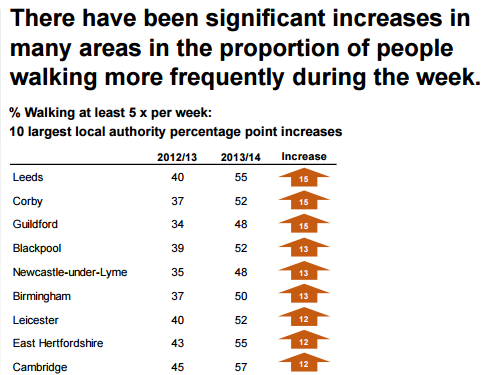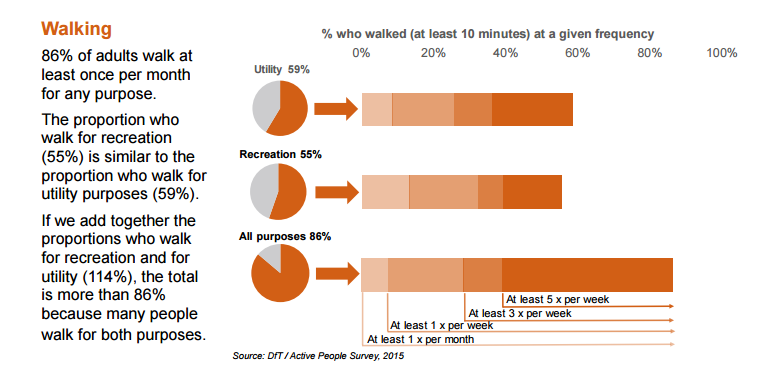
I have a silly walk and I’d like to obtain a government grant to help me develop it.
Reading this Department of Transport statistical release on walking and cycling has made me think I’ve been doing it all wrong all these years.
In fact it’s made me realise I’m so confused about walking that it would be worthless the statisticians even considering canvassing my opinion.
I blame my ‘70s childhood. We were naive about so much back then. “Rolf Harris doing a stretch” would simply have referred to the preparation of one of those massive canvasses he sploshed paint over during one of his massively popular TV shows. Similarly, walking was just something that happened between getting up in the morning and going to sleep. Nobody questioned anything. We just didn’t consider the implications.
When I was a lad my mum used to send me out for a quarter of kayli and a bag of spanish (that’s rainbow crystals and hard liquorice for anyone not from round here). Fretwell’s newsagents was a good five minutes away. I’d walk back carrying my load of sugared food dye, empty calories and tooth demolishing confectionery. Everyone did it.
If my mates called around later we’d probably go hang around the same parade of shops. Or maybe we’d mess about in the woods till we got tired and then go throw bricks in the Orangey – a small artificial lake created by the outflow of a local tannery that frothed when stagnant and put holes in your school pants if you ever got splashed. Brilliant fun. We’d be out for hours.
Nobody thought about it. We didn’t walk because we’d been informed it was good for our health or owing to the discovery that it could be a rewarding leisure activity.
But I was born in unenlightened, gullible times when conceptual confusion was rife. You could get away with anything back then, even believing going to the shops and going out to play were the same sort of thing, statistically speaking.
According to the document I just read this will not do. Distinctions have to be drawn. The frequency of walking for utility purposes and of recreational walking must be distinguished. Science and statistics have made great advances in the theoretical understanding of the many purposes of walking and it is a sign of backward thinking to get them all mixed up. Amazingly, many people manage to walk for both purposes, which just goes to show the tremendous ingenuity and adaptability of the human species.

Unfortunately my brain just can’t make it much beyond the introduction to this document, which reveals that
there were increases of 15 percentage points in the proportion of people walking at least 5 times a week in the local authority of Leeds
and that
86% of adults walk at least once per month for any purpose.
I’m not a statistician so these figures leave me none the wiser. What were those extra 15% of walks for? Where were people going? And how come 14% of our vibrant, energetic, aspirational city see no reason to rouse themselves from slumber and do like our bipedal equipment was designed for? Fair enough, hunting and gathering has long since been out of fashion except for a few TV survivalist types, but surely it’s not too demanding to expect that people might at least leave the house once in a while? It’s not like they have to track and kill a mastodon or carry a pail of murky water back to the cave. A walk to the ice cream van counts (though for statistical purposes only if the ice cream van was in the next street.)
My theory is that the extra 15% of walkers are actively facilitating the couch potatoes in exercise avoidance behaviours. The increased 15% in walking is accounted for by people off down the shops to get fags and beer for the 14% of fitness dodgers who clog up our civic arteries.
The statistics can’t prove otherwise.
In fact I suspect things could be even worse. The survey was conducted exclusively by landlane. What if the first thousand or so the statisticians phoned were too lazy to answer? Speaking for myself I know there’s plenty of times when the landline rings and I’m in a different room and think to myself if it’s important they’ll call the mobile. And I’m one of those statistical anomalies that walks everywhere, purposely. If I can’t be arsed to answer a landline imagine what the seriously activity-averse are like… that figure of 14% becomes increasingly flawed, don’t you think? My guess is that the exercise deficient eat up a much bigger slice of that pie chart.
According to the final page of the document we anticipate these statistics being used in the evaluation of local area interventions to encourage sustainable travel … as background information in the development and targeting of policies, for ministerial briefing and to answer public enquiries.
It makes you wonder if the 14% or more who never leave the house aren’t the most sensible of statistics.